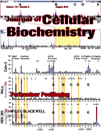
BIOCHIMICA ET BIOPHYSICA ACTA-MOLECULAR CELL RESEARCH
Scope & Guideline
Connecting researchers with breakthrough insights.
Introduction
Aims and Scopes
- Molecular Mechanisms of Disease:
Focuses on the molecular basis of diseases, exploring how molecular interactions and pathways contribute to disease processes, including cancer, neurodegeneration, and metabolic disorders. - Cell Signaling Pathways:
Investigates the intricate signaling pathways that regulate cellular functions, including growth, differentiation, and apoptosis, with a particular emphasis on how dysregulation contributes to disease. - Gene Regulation and Expression:
Studies the mechanisms of gene regulation, including transcriptional and post-transcriptional modifications, and their implications in cellular function and pathology. - Proteomics and Metabolomics:
Utilizes high-throughput proteomic and metabolomic approaches to understand the dynamic changes in protein and metabolite profiles in various biological contexts, particularly in disease states. - Cellular Responses to Stress:
Explores how cells respond to various stressors, including oxidative stress, nutrient deprivation, and hypoxia, and the implications of these responses in health and disease. - Innovative Therapeutic Strategies:
Presents research on novel therapeutic approaches targeting molecular pathways involved in disease, including drug discovery and development based on molecular mechanisms.
Trending and Emerging
- Cancer Metabolism:
An increasing number of studies are focusing on the metabolic reprogramming of cancer cells, highlighting the role of metabolic pathways in tumor progression and therapeutic resistance. - Role of Non-Coding RNAs:
Research on long non-coding RNAs and their regulatory roles in gene expression and cellular processes is emerging as a significant area of interest, particularly in cancer biology. - Immunometabolism:
There is a growing focus on the intersection of immunology and metabolism, exploring how metabolic changes influence immune cell function and the implications for diseases such as cancer and autoimmune disorders. - Cellular Senescence and Aging:
The study of cellular senescence and its impact on aging and age-related diseases is trending, as researchers seek to understand the mechanisms that link senescence to various pathologies. - Organelle Interactions and Communication:
Emerging studies are highlighting the importance of inter-organelle communication, particularly between mitochondria and the endoplasmic reticulum, in maintaining cellular homeostasis and responding to stress. - Microbiome Interactions:
Research exploring the interactions between the microbiome and host cellular processes is gaining momentum, particularly in the context of metabolic diseases and cancer.
Declining or Waning
- Classical Biochemical Assays:
Research utilizing traditional biochemical assays for enzyme activity and metabolic profiling has decreased, likely due to the rise of more advanced techniques such as high-throughput screening and omics technologies. - Basic Cell Biology:
Studies that primarily focus on fundamental cell biology without a direct application to disease mechanisms or therapeutic implications are less frequently published, indicating a shift towards more applied research. - Single-Cell Analysis:
Although single-cell analysis was once a rapidly growing area, its prominence has waned slightly as the field matures and researchers increasingly integrate single-cell findings into broader biological and clinical contexts. - Static Models of Disease:
The reliance on static models to study disease mechanisms, such as 2D cell cultures, has decreased in favor of more dynamic and physiologically relevant models, including organoids and in vivo studies.
Similar Journals

Cell Death Discovery
Advancing insights into the mysteries of cell death.Cell Death Discovery, published by Springer Nature, is a distinguished open-access journal dedicated to advancing the field of cell death research. Since its inception in 2015, the journal has rapidly established itself as a premier platform for high-quality research, currently holding a remarkable position in the Q1 quartiles across multiple categories, including Cancer Research, Cell Biology, Cellular and Molecular Neuroscience, and Immunology. With an impact factor reflecting its significant contribution to the scientific community, Cell Death Discovery invites submissions that explore the molecular mechanisms of cell death and its implications across various biomedical fields. The journal's open-access model ensures that groundbreaking research is accessible to a global audience, facilitating collaboration and dissemination among researchers, professionals, and students alike. Located in the UK, at CAMPUS, 4 CRINAN ST, LONDON N1 9XW, ENGLAND, the journal continues to support innovative scholarship and foster a deeper understanding of the processes behind cell viability, development, and disease.

BIOCHEMICAL JOURNAL
Illuminating the Path of Molecular DiscoveryBIOCHEMICAL JOURNAL, published by Portland Press Ltd, stands as a leading publication in the fields of Biochemistry, Cell Biology, and Molecular Biology, reflecting a commitment to advancing scientific knowledge since its inception in 1945. With a distinguished Q1 ranking across these categories and impressive Scopus rankings, the journal serves as an invaluable resource for researchers, professionals, and students alike, facilitating critical discoveries and innovative research practices. Although not currently offering open access, the journal provides a platform for high-quality peer-reviewed articles, ensuring rigorous standards in the dissemination of biochemical research. Spanning over seven decades and continuing through to 2024, the BIOCHEMICAL JOURNAL fosters an environment where cutting-edge biochemical research thrives, supporting the global scientific community's efforts to address complex biological questions and enhance our understanding of fundamental cellular processes.

CELL RESEARCH
Elevating Insights in Cell and Molecular SciencesCELL RESEARCH is a premier peer-reviewed journal dedicated to advancing the field of cell biology and molecular biology, published by SpringerNature. With an impressive impact factor and consistently ranking in the Q1 quartile for both cell biology and molecular biology, this journal serves as a pivotal resource for researchers, professionals, and students seeking to explore the latest discoveries and advancements in cellular mechanisms and their implications for health and disease. Since its inception in 1996, CELL RESEARCH has cultivated a distinguished reputation, currently boasting ranks in the top percentile of Scopus categories, reaffirming its influence and relevance to the scientific community. Although it is not an Open Access journal, its rigorous selection process ensures the publication of high-quality articles that contribute significantly to our understanding of life sciences. For those deeply engaged in the realms of biochemistry, genetics, and molecular biology, CELL RESEARCH is an essential conduit of innovative research and critical insights.

CELLULAR AND MOLECULAR BIOLOGY
Exploring the Intricacies of Cellular MechanismsCellular and Molecular Biology is a prominent academic journal published by C M B ASSOC, specializing in the dynamic fields of cellular and molecular biology. Established in 1977, this journal has consistently aimed to disseminate groundbreaking research that contributes to our understanding of biochemical processes, cell dynamics, and molecular mechanisms governing life. With its ISSN 0145-5680 and E-ISSN 1165-158X, the journal plays a vital role in the exchange of innovative ideas, evidenced by its coverage of research from 1977 to 2024. Although currently categorized in the Q4 quartile for major disciplines such as Biochemistry and Cell Biology, it is dedicated to fostering the development of the field by welcoming submissions that challenge the conventional understanding and lead to novel insights. Researchers and academics looking to contribute to or stay updated in the rapidly evolving landscape of molecular biology will find this journal a valuable resource for connecting with a global community of scientists.

MOLECULAR AND CELLULAR BIOLOGY
Pioneering Research in Cell Biology ExcellenceMOLECULAR AND CELLULAR BIOLOGY, published by TAYLOR & FRANCIS INC, stands as a preeminent platform for researchers, professionals, and students engaged in the dynamic field of molecular and cellular biology. Established in 1981 and ongoing into 2024, the journal features cutting-edge research that spans across vital sub-disciplines, garnering a strong impact in its contributions to the scientific community. With an impressive Q2 ranking in Cell Biology and Q1 ranking in Molecular Biology for 2023, it consistently publishes high-quality articles that reflect the latest advancements and discoveries within the field. The journal is particularly well-regarded for its rigorous peer-review process and commitment to scientific excellence, making it an invaluable resource for those seeking to deepen their understanding of molecular mechanisms and cellular processes. Although not open access, the journal offers diverse access options for researchers to reach the latest findings. By maintaining a strong focus on biochemistry, genetics, and molecular biology, MOLECULAR AND CELLULAR BIOLOGY remains essential reading for anyone looking to contribute to or stay informed about significant developments within this pivotal area of study.

CELLULAR PHYSIOLOGY AND BIOCHEMISTRY
Connecting Researchers through Open Access ScholarshipCellular Physiology and Biochemistry is a premier Open Access journal published by the prestigious Cell Physiol Biochem Press GmbH & Co, dedicated to advancing research in the fields of physiology, biochemistry, and molecular biology. Since its inception in 1987 and transitioning to an Open Access model in 2013, the journal has established itself as a vital resource for the dissemination of high-quality research and reviews, showcasing innovative methodologies and groundbreaking findings in cellular processes. With an impressive ranking in the 2023 Scopus category as Q2 in Physiology and a robust percentile of 61, Cellular Physiology and Biochemistry is committed to fostering academic dialogue among researchers, professionals, and students alike. This journal not only provides unrestricted access to its articles, but also promotes the global sharing of knowledge, which is essential for the advancement of our understanding in these vital scientific areas. The journal's editorial team is dedicated to ensuring the highest standards of academic rigor and relevance, making it an indispensable addition to the libraries of those engaged in the life sciences.

Cell Stress
Connecting Researchers to Transform Molecular MedicineCell Stress is a prestigious, peer-reviewed open access journal dedicated to advancing research in the fields of biochemistry, genetics, molecular biology, cancer research, and physiology. Published by SHARED SCIENCE PUBLISHERS OG in Austria, this journal has rapidly established itself since its inception in 2017, achieving Q1 status in multiple categories, indicative of its high impact and quality. With an impressive Scopus ranking—holding a top percentile position in its respective fields—Cell Stress aims to foster interdisciplinary collaboration and disseminate cutting-edge findings that enhance our understanding of cellular stress mechanisms and their implications in health and disease. The journal's commitment to open access since its launch ensures that critical research is accessible to a global audience, thereby facilitating the exchange of knowledge among researchers, professionals, and students alike. Address your submissions or inquiries to AM BLUMENHAG 25-4, Graz 8010, Austria, and contribute to this dynamic platform that is shaping the future of molecular medicine.

JOURNAL OF CELLULAR BIOCHEMISTRY
Transforming Knowledge into Breakthroughs in Cellular BiochemistryJournal of Cellular Biochemistry is a premier academic journal dedicated to advancing the field of biochemistry and cellular biology. Published by Wiley, this influential journal has a significant impact factor that underscores its relevance and authority within the scientific community. With its ISSN 0730-2312 and E-ISSN 1097-4644, the journal has been on the frontier of research since its inception in 1982, and is expected to continue publishing cutting-edge studies through 2024. As evidenced by its ranking in the 2023 Scopus Quartiles, it holds a rank of Q2 in Biochemistry and Q3 in both Cell and Molecular Biology, placing it among the top tiers of scientific journals in these disciplines. The Journal of Cellular Biochemistry serves as a vital resource for researchers, professionals, and students alike, providing a platform for the dissemination of innovative ideas and findings that shape our understanding of cellular processes and biochemical pathways. Though it does not currently offer Open Access options, its robust peer-review process ensures that each publication meets the highest academic standards, thus solidifying its esteemed position in the landscape of biochemical research.

Open Biology
Advancing the frontiers of life sciences.Open Biology is a prestigious, interdisciplinary journal published by the Royal Society that has been paving the way in the fields of Biochemistry, Genetics and Molecular Biology, Immunology, and Neuroscience since its inception in 2011. Catering to a global audience of researchers, professionals, and students, Open Biology operates under an open access model, facilitating the unrestricted dissemination of high-quality research findings. With a current impact factor that positions its categories in the top quartile (Q1) and impressive Scopus rankings—evidencing its influence and reach—this journal serves as a vital platform for innovators and scientific inquiries aimed at advancing our understanding of life sciences. The journal's commitment to publishing cutting-edge research makes it an essential resource for those at the forefront of scientific exploration.

NATURE REVIEWS MOLECULAR CELL BIOLOGY
Empowering scientists with critical reviews and discoveries.NATURE REVIEWS MOLECULAR CELL BIOLOGY, published by NATURE PORTFOLIO, stands as a seminal journal in the fields of cell and molecular biology, with a significant impact factor that underscores its influence and reputation within the scientific community. Established in 2000 and continuing its legacy into 2024, this journal delivers comprehensive reviews that synthesize current knowledge and advancements in molecular and cellular processes. Respected for its high-quality articles, it has maintained a prestigious Q1 ranking in both Cell Biology and Molecular Biology categories as of 2023. With an exceptional Scopus ranking, taking the top position in its category, it attracts a readership of prominent researchers, professionals, and students eager to stay abreast of groundbreaking discoveries and methodologies. Although it does not offer Open Access, subscribers benefit from exclusive access to vital insights that foster innovative research approaches and advancements in the life sciences. The journal’s objective is to bridge the gap between research and application, providing indispensable resources to its audience while contributing to the global conversation on molecular and cellular biology.